23 Ways to Make Your Home & Yard More Eco-Friendly
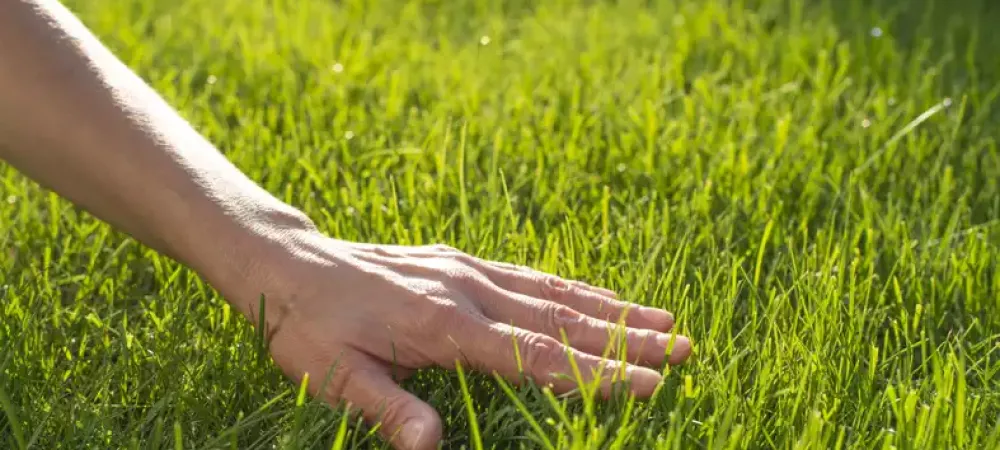
To help homeowners throughout Illinois make lasting change in how they care for their homes and properties, we reached out to the experts.
Connecting with educators, researchers, and leaders of environmental non-profits throughout Illinois, we asked them for their favorite tips for living a more natural, environmentally-responsible lifestyle. We were looking for practical advice on how to lower our environmental impact while caring for our lawns, plants & gardens, and homes.
Here’s the exact question we asked the experts:
What do you wish every homeowner knew about caring for their home or yard in an eco-friendly way?
Practical Tips from the Experts
The response we received for this question was overwhelmingly positive, with tons of practical advice for caring for your lawn, plants, and home. We’ve compiled our favorite responses into this helpful guide. Below you will find all 23 tips, including how you can protect your storm drains, why you should listen to your weeds, and our most popular tip.
If you find these tips helpful, we would love it if you would share this guide with your friends and family on your favorite social platform.
Lawn Care Tips
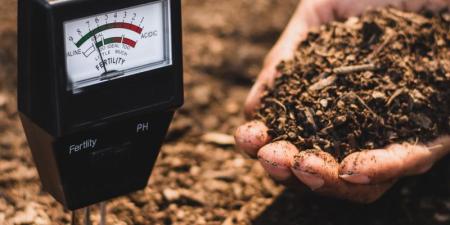
1. Get Your Soil Tested
The one common denominator that affects your property’s lawn, plants, trees, and garden? Your soil.
By knowing your soil’s specific chemistry, including pH levels and nutrient deficiencies, you can avoid adding harmful chemicals and too much fertilizer, both of which can have a negative impact on local plants, wildlife, and river systems. Here’s why Kathleen Connolly thinks a soil test is important:
Start with a soil test, the time-proven gateway to building optimal soil health—and dense turf. If you’ve got the wrong pH in lawn soil, you are probably on a path to grass frustration and failure. When pH is correct, plants are better able to access soil nutrients… When we create optimal conditions for lawns and gardens, we avoid frustration and the need for expensive, labor-intensive–and sometimes toxic–treatments later on.
Connolly also said a soil test should include more than just the soil’s pH level; it should also report on organic matter and presence of salts. According to Kathleen:
These extra reports may cost a bit more, but they are critical to success. If organic matter is low, below five percent, the living community of soil microbes will not thrive. These microbes are critical to turf health.
2. Keep Your Yard Pesticide-Free

Pesticides and other store-bought lawn products can make your yard looking great and healthy, but at a cost: these chemicals can be toxic and harmful to your family and the environment. By relying on natural remedies, planting native plants, and watering correctly, you can keep your yard healthy, pesticide-free, and safe for everyone.
Gregg Wartgow, editor of Green Industry Pros magazine, suggests that we treat our lawns like we treat our skin:
Don’t assume you or your lawn contractor has to relentlessly pile fertilizers and pesticides on your lawn to make it look beautiful. Think of your lawn like your skin. Yes, you can spend lots and lots of money on skin care products and makeup, but any good dermatologist will tell you that what is important is laying the groundwork for healthy skin = proper washing and moisturizing. No harsh soaps or medications!! Likewise, you need to nurture your lawn so that it is healthier and more resistant to weeds, disease and insects.
Dan Meyers, editor of The Garden Counselor, wants homeowners to practice due diligence, even when it comes to organic treatments:
Educate yourself, evaluate the source and use common sense. Don’t assume that the terms “Natural” or “Organic” must guarantee that something is safe or appropriate for your situation at any time. Your best intentions for “Green Gardening” can be waylaid by improper or even harmful suggestions. Choosing a supposedly natural product that is inappropriate, or using a technique in the wrong way or at the wrong time, can result in wasted resources as well as potentially harm your backyard ecosystem.
3. Be the Steward of Your Street’s Storm Drain
You may not realize it, but the storm drain at your curb is an important part of your local environment — which is both good and bad. On the positive side, a storm drain allows excess rain water to leave your property, so your yard and plants (and basement!) aren’t destroyed by a flood. On the negative side, this water can carry automobile oil, chemicals, and fertilizers from your hard surfaces — including driveways, sidewalks, and roads — introducing them into nearby lakes and streams.
Here’s how the Friends of the Fox River explain it:
Be the steward of your street’s storm drain, as it is a conduit to your local wetlands and streams. Especially protect it from fertilizer. Limit any chemical uses that could run off into the drain. If you have a lawn care service, make certain that they do not leave any product on the pavement.
Ethan Brown from the Alliance for the Great Lakes suggests homeowners disconnect their downspouts to limit the amount of water entering the storm drain system. He says:
Disconnecting your home’s downspouts so rainwater absorbs into the ground rather than adding to stormwater pipes goes a long way to protecting our local rivers, streams, creeks and – if you live near it – Lake Michigan! Common during strong rain events, excessive rainwater in storm sewers can erode and pollute local rivers, streams, and creeks.
By directing rainwater away from storm drains and into the ground, it not only protects your local rivers, you also send that water into the local aquifer, which provides us with clean drinking water.
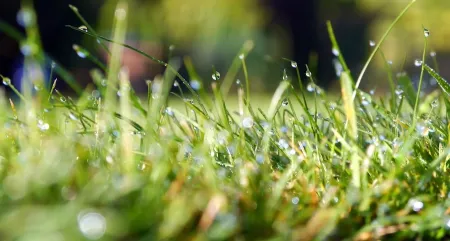
4. Keep Your Grass Long
If you have a lot of space on your property, consider letting your grass grow long. Not only will it save you time by cutting it less, but it reduces the amount of fertilizer and lawn care treatments you use. Ian Kenney from the Illinois Natural History Survey suggests planting your property with prairie grass. This provides a more natural, prairie-like look that’s native to most parts of Illinois. Ryan Anderson from the Midwest Pesticide Action Center agrees with letting your grass grow long, recommending to mow your lawn to no less than three inches.
Mark Opal, President of the former Illinois Professional Lawn Care Association, suggests leaving the grass grow long, as it means more grass to out-compete the weeds for available sunlight and nutrients. Pete Galuppo, describes this:
One of the best ways to minimize the need for additional weed control throughout the year is to keep your mower height at its highest setting during the summer. Your best weed control is a thick, healthy lawn. As the weather gets hotter, our cool season grasses tend to get thinner allowing for more weeds to take over. If you want to reduce pesticides, this is a great place to start.
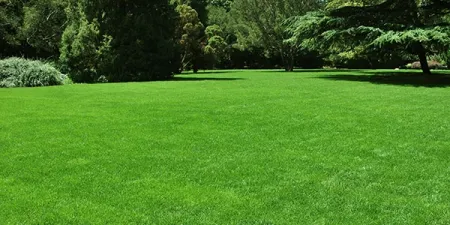
5. Stop Overwatering Your Lawn
Water is a vital resource your plants and lawn needs to grow in a natural and healthy way. Too much water — like watering your grass daily — is unnecessary; in fact, doing so can lead to increased chemical and pesticide use.
Kevin Vogeler of Turf Care Enterprises suggests cutting back on your watering frequency to promote deep roots for your grass:
The key to healthy turf grass is deep, infrequent watering. When you water lightly and frequently, you are encouraging a shallow rooted lawn. Shallow roots cannot get at moisture held deep in the soil, making grass dependent on more frequent sprinklings — especially during warm, dry periods.
With proper nutrition, aeration, high mowing, and the right amount of watering, you can help your lawn develop a deep root system that usually requires very little watering for survival.
Ruth Kerzee from the Midwest Pesticide Action Center agrees, and recommends homeowners use a rain gauge to measure how much water their lawn is receiving:
It takes just 1″ of water a week to maintain a healthy lawn and encourage strong roots to help out compete weeds. Don’t have a rain gauge? Use an empty tuna can instead. Shut the water off when it reaches the top. You’re done for the week!
If you have a yard sprinkler system, make sure you schedule your sprinklers at the right time. Vogeler explains:
Make sure to stop your sprinklers a few hours before nightfall to allow the grass surface to completely dry. Moisture on the grass blades for long periods encourages the development and spread of many turf diseases and could increase the need for chemical fungicides.
6. Reuse Your Yard’s Clippings and Leaves
When you trim your yard, don’t let those grass clippings go to waste; reuse them as a nutrient-rich additive for your property’s plants.
Allison Frederick from the Lake County Forest Preserves suggests using a mulching mower instead of a bagger; this helps your lawn receive nutrients from the grass clippings. If you must bag your clippings, you can compost them — along with mulched leaves — to use as a natural fertilizer for your garden or flower beds.
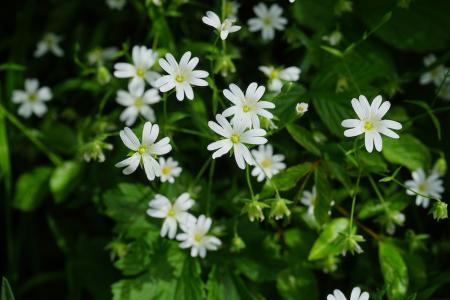
7. Listen to Your Weeds
While weeds are undesirable for most lawns, they can provide you with valuable information. Kathleen Connolly explains:
Turf weeds indicate unfavorable soil conditions. For example, plantain and dandelions are associated with soil compaction. Lawn aeration and compost applications reduce compaction, making conditions less favorable for plants that are happy to live where grass will not.
By treating the underlying problems with your home’s soil, you will not only help take care of your weed problems, you’ll also help your lawn and plant grow healthier.
Plants & Garden Tips
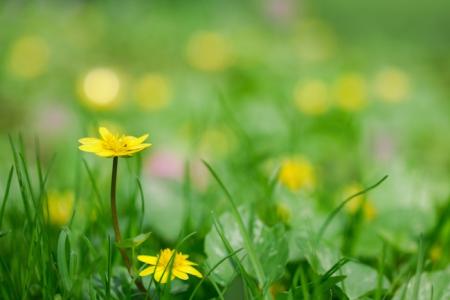
8. Know Your Plants
The first step to any problem is knowing what the problem is. And if you are looking to treat and care for the trees, shrubs, and plants on your property, you need to know what they are. That’s why Scott Schirmer from the Illinois Department of Agriculture suggests homeowners create a plant inventory:
I feel one of the most important things homeowners can do is to keep inventory of the plants on their properties. By knowing what they have in their landscape, they can effectively scout for likely problems (pests, diseases, environmental conditions) which could help to quickly find, identify, and mitigate any potential issues.
Scott went on to say that a plant inventory for your property can help you diversify your landscape, which would minimize a large-scale loss from a pest that targets a specific species — like a boxwood blight or EAB with ash trees. If you can’t come up with a plant inventory for your home, a certified arborist or lawn care company could help you in drafting one.

9. Make Sure Your New Plants Are Healthy
A key way to keep your plants healthy is to make sure they are healthy when you first plant them. That’s why Scott Schirmer from the Illinois Department of Agriculture encourages homeowners to purchase their plants and trees from trustworthy sources:
Source landscape plants and materials from licensed or reputable sources (nurseries, greenhouses, landscape material retailers) to minimize risk associated with introducing diseased or infested plants or materials to your landscape.
Gabriela Rocha of the Chicago Botanic Garden says “planning is the key in the backyard”:
Do some research before getting a new plant. Verify its water and climate requirements and don’t go for exotic plants that require more from you -and the environment Don’t follow plant trends and just buy what you really are able to care for.
Your local greenhouse or nursery staff can help you identify healthy plants and saplings, which have a better chance to grow into healthy shrubs and trees on your property.
10. Compost Your Organic Waste
Many homeowners in Illinois have to deal with clay and nutrient-deficient soils. To add nutrients to your soil, consider composting your organic waste.
Jim Kleinwachter from The Conservation Foundation says usable organic waste is everywhere inside and outside your home:
Keep all your leaves, shred them with a mower, add kitchen scraps and work them into the soil to create rich growing environments for your garden, lawn, or flower beds
Rafael Arredondo of the Chicago Botanic Garden suggests investing in a compost tumbler
Compost tumblers are great; they do not require a lot of space, they are easy maintenance, and you get compost in less than a month.
Using organic waste from your yard or kitchen table return nitrogen and other vital nutrients into your soil, providing your garden, flowers, and grass an extra boost of natural fertilizer.
11. Brew Compost Tea
If you follow the previous tip and start composting your organic waste, you might want to know how to best use the compost to improve your plants and lawn. One suggestion is to create compost tea, which you can apply directly to the soil or yard.
Here’s the recipe, sent to us by Britt Calendo of the Chicago Botanic Garden:
In a 5-gallon bucket, fill it about 1/3 of the way with organic compost. Fill the buckets an inch or 2 below the top with water. Let it sit for 5-7 days, stirring occasionally. At the end of 5-7 days, strain the mixture through a piece of burlap or with a strainer. You can add the compost tea to your soil or grass with a watering can or simple garden sprayer. For best results apply compost tea every 2 weeks until about mid-July.
So instead of waiting for your compost to turn into nutrient-rich soil, brew some compost tea and get those nutrients directly to the plants within the week.

12. Add Native Plants to Your Yard
This was by far our most popular tip, with 48% of our experts offering this as one of their Earth Day tips.
Why is this such an important topic?
We think there are two reasons for this large response. First, the trend towards exotic plants means homeowners are using less plants native to Illinois. Many of these plants are not well suited for our environment, which leads to more fertilizer and water usage to keep these plants looking good. Second, homeowners moving towards having the same type of flowers, plants, and trees leads to a decrease in biodiversity. Allison Frederick from the Lake County Forest Preserves explains the importance of biodiversity:
Native flowers, grasses, and forbs play a critical role in increasing biodiversity – the variety of species living in a particular habitat. These indigenous plants help maintain native diversity by providing food and homes for insects, birds and mammals. In recent years, there has been increasing recognition of the importance of preserving biodiversity. Biodiversity is important for such ecosystem processes as water purification, recycling nutrients and providing fertile soil, preventing erosion and facilitating pollination.
Many of our experts suggested planting grasses and plants that are native to Illinois. That would include prairie grasses, native flowers, wildflowers, and trees. That’s because native plants are acclimated to the local environment and rainfall, as well as providing habitats for wildlife.
Here are some reasons why you should plant native:
Benefits to Natural Wildlife
Several experts cited the benefits to natural wildlife as a reason for using native plants. Valerie Keener from the Illinois Department of Natural Resources said:
Native plants provide beauty as well as food and shelter for wildlife. Native species are adapted to the Illinois climate. They require little or no watering and are resistant to drought, insects and most diseases. Because they are perennials, you can welcome their presence year after year.
Kevin Cummings from the Illinois Natural History Survey suggested flowers that attract butterflies to help boost their populations, while Lisa Haderlein from The Land Conservancy of McHenry County suggested planting oak trees because they are great for birds, mammals, and caterpillars.
Minimize Soil Erosion
Some experts mentioned how native plants are great for minimizing water damage and soil erosion. Rachel Goad from the Chicago Botanic Garden said:
Use native plants! They help support native pollinators and birds, and prairie species can help to abate flooding and reduce erosion as a result of their deep roots.
The Illinois Native Plant Society echoes Rachel’s comment on reducing soil loss:
[Native] plants have deep or fibrous roots, they can help to reduce erosion and speed water infiltration.
Natural Landscaping is Beautiful and Healthy
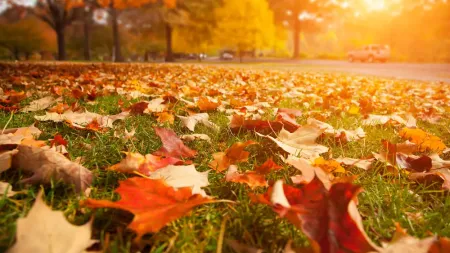
Many of our experts highlighted the fact that native, prairie landscaping can make your home look great. That’s the point Todd VanMiddlesworth from the Illinois Natural History Survey made, saying:
[I would] encourage people to plant native prairie plants on their home. This is great because it can be aesthetically pleasing to people, low maintenance, and serve as habitat for all sorts of wildlife.
Janet Beach Davis from the Environmental Education Association of Illinois suggests practical reasons why using native plants can be beneficial:
Plant natives! It reduces your water needs (after the first year you never need to water again) and they are perennial, so you don’t need to replant. They are homes and food for our lovely native butterflies. That saves time, money, and the ecosystem.
Jennifer Day Tariq from the Douglas-Hart Nature Center notes how native prairie plants are flexible enough to provide any type of look for your home’s landscape:
These plants can be planted in the same beds as their spring bulbs! Illinois native prairie plants are adapted to changing environmental conditions like having deep root systems to find water during dry seasons, benefit wildlife and pollinators, spring back to life as perennials every year, have varying plant heights from several inches to several feet high to fulfill any landscaping need, and of course the aesthetic appearance of their natural beauty and appearance.
Reduce Pesticide Usage
Prairie plants and grasses can also help minimize the amount of mosquitoes and annoying bugs on your property, so you don’t have to spray pesticides. Says Samuel Vergara of the Chicago Botanic Garden,
Planting native plants, grasses, and sedges can help soak up excess water that may pool up around your home, while attracting beneficial bugs to your garden! No need to spray pesticides when you have native natural predators helping you out.
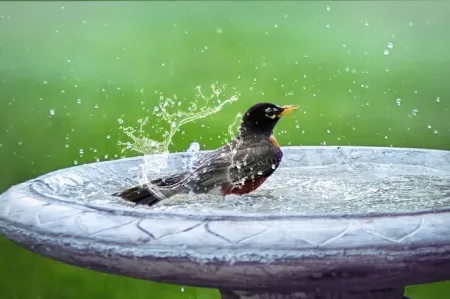
Native Plants Attract Native Animals
Several of our experts mentioned how native plants attract and encourage native wildlife. Steven HIll from the Prairie Research Institute of the University of Illinois said:
Plant native berry bushes and prairie plants such as the native sunflowers, cup plants, elderberries and so on to encourage our native birds and other animals.
Jo Fessett of the Illinois Audobon Society echoed Steven’s suggestion, saying native plants provide the right amount of shelter for native animals:
All creatures need four basic things to survive: food, water, shelter, and a suitable place to raise their young. By choosing plantings which provide any of these you can enhance your backyard habitat for wildlife. Native plantings are the way to go for best seed and berry sources, as well as nesting sites.
Advice for Planting Native
For those looking for practical tips on getting started with native plants, David Zeiger from the Land Conservancy of McHenry County has some great advice:
I recommend taking a risk with native prairie plants that are of short/medium height. Choose an area to experiment with. Research plants that suit your area. In a brief time you will have a garden that attracts all sorts of creatures including butterflies, bees and birds. Our home garden attracted a hummingbird moth. We had never seen one before! A prairie garden will bring years of enjoyment and is easily maintained… Native gardens are full of action and curiosities – terrific for child exploration and inquiry. Celebrate and take care of this beautiful earth that sustains us.
Christopher Whelan from the Illinois Natural History Survey sent us a list of native plants that will attract native wildlife to your backyard:
Landscape for birds and small mammals (squirrels, chipmunks) with native fruit-producing shrubs, and include some conifer plantings if possible, as they provide great cover and seem to be associated with greater bird diversity in urban residential backyards. Native shrubs to consider include various Viburnums (Viburnum spp), dogwoods (Cornus spp), and red cedar (Juniperus virginiana) for birds, and hazelnut (Corylus americana) for squirrels. Juneberries (Amelanchier spp) are great and are small trees or shrubs, whose berries are eaten by many bird species, as well as chipmunks and squirrels.
From aesthetics to water conservation to helping wildlife, it’s no wonder why so many environmental experts in Illinois recommend adding native grasses, plants, and trees to your home’s landscaping.
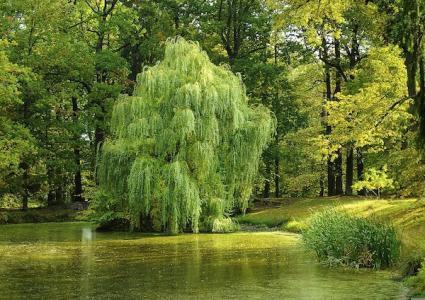
13. Plant Trees to the South of Your Home
If you are looking to incorporate native trees to your home’s landscaping, consider planting a large deciduous tree to the south of your home. This tip, sent to us by Anissa Chaudhry of the Lake Forest Open Lands, allows homeowners to enjoy the natural, climate-controlling effects of a tree:
In the summer, it would provide a shield from the strong southern sun, thus reducing your cooling costs. In the winter, when the leaves are gone, it would provide access to the southern exposure, thus reducing your heating costs. In short, plant a tree!
14. Diversify Your Neighborhood’s Tree Population
While you are planting trees based on the last tip, consider planting different trees than what you find in your neighborhood. That’s the advice from Reinee Hildebrandt of the Illinois Urban and Community Forestry Program, saying:
Help your community diversity its neighborhood forests by planting a tree that is a different species than your neighbors. A community forest should have no more than 30 % of one family, 20% of one genus and 10% of one species of trees. Help the state and nation avoid another Dutch Elm Disease or Emerald Ash Borer epidemic.
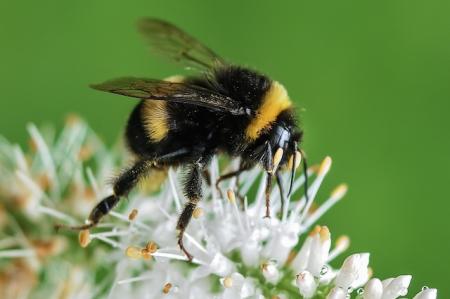
15. Plant Bee-Friendly Plants in Your Yard
Bees are nature’s great pollinator. Most plants depend on bees to naturally pollinate, allowing the plants to reproduce. This includes plants we depend on for nutrition and food. André Copeland of the Brookfield Zoo says that honeybees are responsible for pollinating 1/3 of our diet! Unfortunately, our bee population is collapsing and their habitats are disappearing.
To remedy this, Copeland suggests homeowners create a bee-friendly habitat in their own backyard:
Planting vegetable gardens, native wildflowers and milkweed using pesticide-free gardening techniques is healthy for you and pollinators, too.
The Chicago Zoological Society has created a helpful list of native plants that are both beautiful and friendly to bees and other pollinators.
16. Identify Invasive Species and Remove Them
Illinois homeowners are no strangers to invasive species, especially all the news about Emerald ash borer and Asian carp. Aside from these well-known invaders, we face dozens of other insects, grasses, and plants that are not native to Illinois but threaten to push out native plants and wildlife.
Allison Frederick from the Lake County Forest Preserves suggests that all homeowners take a survey of their property to identify invasive species, and if spotted to take steps to remove the intruders. This can be done by an ISA-certified arborist or landscaping company. Local communities also provide resources to help homeowners identify these intruders.
Steven Hill from the Prairie Research Institute of the University of Illinois says you need to take drastic action to remove invasive species, before they have a chance to spread:
Uproot and destroy non-native invasive shrubs and trees, especially shrub honeysucke, Siberian elm, Japanese honeysuckle, white mulberry, privets, and also the herbs such as garlic mustard. Remove and do not plant any English ivy – it leads to a barren desert for any other plant.
Invasive species can have a serious impact on aquatic life. That’s why Patrice Charlebois from the Illinois-Indiana Sea Grant suggests using only non-invasive plants and animals for your water garden.
By being proactive, you can save the plants in your and your neighbors’ yards, and keep our region looking naturally beautiful.
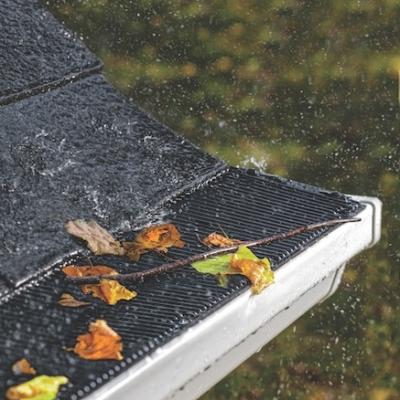
17. Use Rain Barrels to Collect Rainwater
Chris Phillips from the Illinois Natural History Survey calls this next tip a “no-brainer”: using rain barrels to collect rainwater. Most homeowners can easily add a large barrel to the end of their home’s downspout, which collects the water for gardening and other yard uses later. Plus, this can save that water from overwhelming the storm drain.
Jodi Vandermyle from the Illinois Natural History Survey also suggests using a rain barrel to water your garden, because it’s more efficient than sprinklers:
Don’t use sprinklers. You lose a lot of water through evaporation. Use rain barrels instead to water your garden. This will also decrease how frequent you have to mow (i.e. grass will not grow as fast) and reduce fossil fuels used (i.e. gas for mowing).
18. Plant Rain Gardens
To go along with the previous tip about collecting rainwater in rain barrels, the Barrington Area Conservation Trust recommends planting a rain garden. Rain gardens are designed to handle a large amount of water, soaking up storm water before it enters the storm drainage system. Planted in low or flat areas of your property, these gardens usually rely on native plants and trees that are used to high volumes of moisture.
Matt Steffen from the Illinois Environmental Council agrees, saying:
If you’ve had problems with flooding or want to help reduce flooding in your area, consider planting a rain garden. Such gardens allow rainwater runoff from impervious surfaces, like roofs, driveways, etc. opportunity to be absorbed. This reduces rain runoff by allowing storm water to soak into the ground (as opposed to flowing into storm drains and surface waters which causes erosion, water pollution, flooding, and diminished groundwater).
Home Tips
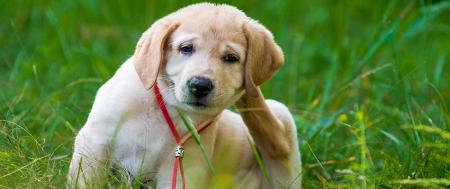
19. Pick Up After Your Pet
Your pets may be beloved members of your family, but their waste — when not picked up — can have a negative impact on the environment. Natalie Marioni from the National Great Rivers Research and Education Center explains:
Pet waste not only contains undigested chemicals, such as preservatives from pet food, but also parasites and bacteria that can be transmitted to humans. When pet waste is allowed to sit in the grass or on sidewalks, especially near stormwater drains in urban areas, the likelihood that chemicals and bacteria can leech into our groundwater or wash directly into our streams through a runoff event is high… Then there is the direct threat to our health if this pet waste is sitting in areas where you may be gardening and children may be playing. So be mindful of both your health and that of your community, both human and wildlife, and pick up after your pet.
So picking up after your dog not only keeps your yard and sidewalks looking great, it also protects the storm drains and local streams!

20. Ditch the Single-Cup Coffee Pods
Single-serve coffee brewing systems by Keurig, Nespresso, and Verismo have rapidly grown in popularity over the last 5 years. Most love them for their ease of use, fast brewing times, and the thousands of flavors available in the disposable pods.
But with the increase of single-cup coffee pods comes a drastic increase in the amount of plastic heading to the landfill each year, up to 9 billion cups in 2014 alone. While the plastic and metal in each cup is recyclable, most people throw the single use cups away, adding to our ever-growing landfill problem. Keurig has established a K-Cup recycling and return program for workplaces, but it costs money and can be hard to break habits.
Bo Harper of the Lake Bluff Open Lands Association recommends ditching the single cup system altogether, opting for alternative coffee brewing methods. If you must get your caffeine fix from a single-serve system, consider using a reusable pod system. While this might add a few more seconds to your coffee preparation, it helps the environment.
21. Shut off the Water When Brushing Teeth
Virginia Peschke from The Land Conservancy of McHenry County gave us a simple, yet effective tip for conserving water:
Shut off the water when brushing your teeth
This tip makes sense: the EPA figures this can save 200 gallons of water per month. Additional steps you can take to conserve water include repairing leaking or dripping fixtures, washing only full loads in the dishwasher or washing machine, and keeping your showers to under 5 minutes.

22. Use an Eco-Friendly Cleaner in Your Home
Many home cleaning solutions, while leaving your surfaces with a spotless finish, use harsh chemicals that can damage your home’s plants and your communities water sources.
Jess Reese from the Chicagoland Environmental Network gave us some great advice for an eco-friendly cleaner:
The best cleaner for countertops and floors is an eco-friendly blend of vinegar, dish soap, and water. For a great solution mix 2 oz. white vinegar, 1 teaspoon of dish soap, and 16 oz. of water in a spray bottle.
This formula provides enough cleaning power to handle most of the tough spills and stains you’ll face in your home, but in a natural way that’s better for your home and family.
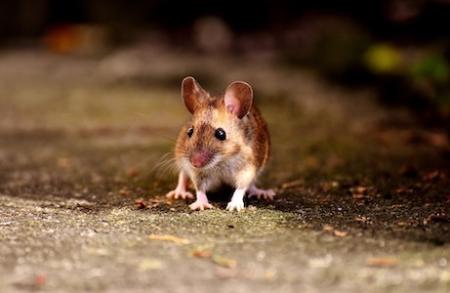
23. Use All-Natural Methods of Preventing Rodents
Pests in your home — including mice and other rodents — are unwelcome guests that most homeowners want gone immediately. Yet many of the traditional methods for killing rodents are harmful to your pets and natural predators, like the red-tailed hawk — which can eat 3 mice per day!
André Copeland from the Brookfield Zoo suggests using all-natural remedies to prevent rodents from entering your home. The first step is to block any entrances and access points into your home:
Seal any possible entries. If a rodent’s head can get through, the body can, so mice can fit through very small openings. Using green kitchen pads cut to the right size is a good way to block small holes. Sticking steel wool in rodent holes will prevent mice from using the hole to enter your house; it’s too tough for them to chew through.
The second stage in all-natural pest control is staying clean. Copeland explains:
Cleanliness means rodent-less. Mice will be less likely to stay if there is nothing to eat so store food properly in airtight containers and in places that are safe from mouse attack.
The final step Copeland gave us is to use peppermint around your home. Here’s why:
Peppermint oil is an all-natural prevention for rodents. The smell is too powerful for rodents so they won’t go near it. Peppermint oil is available in most health food stores and major grocery stores. Place a couple of drops on cotton balls in places mice may enter your house such as doorways or heat vents. Growing peppermint plants near the entryways and cooking mint are good preventive measures also.
Now It’s Your Turn
Hopefully these experts have given you some practical advice that you can apply in your home or yard right away. If we all take steps to lessen our impact on the environment, we can all help ensure Illinois remains beautiful for future generations.

